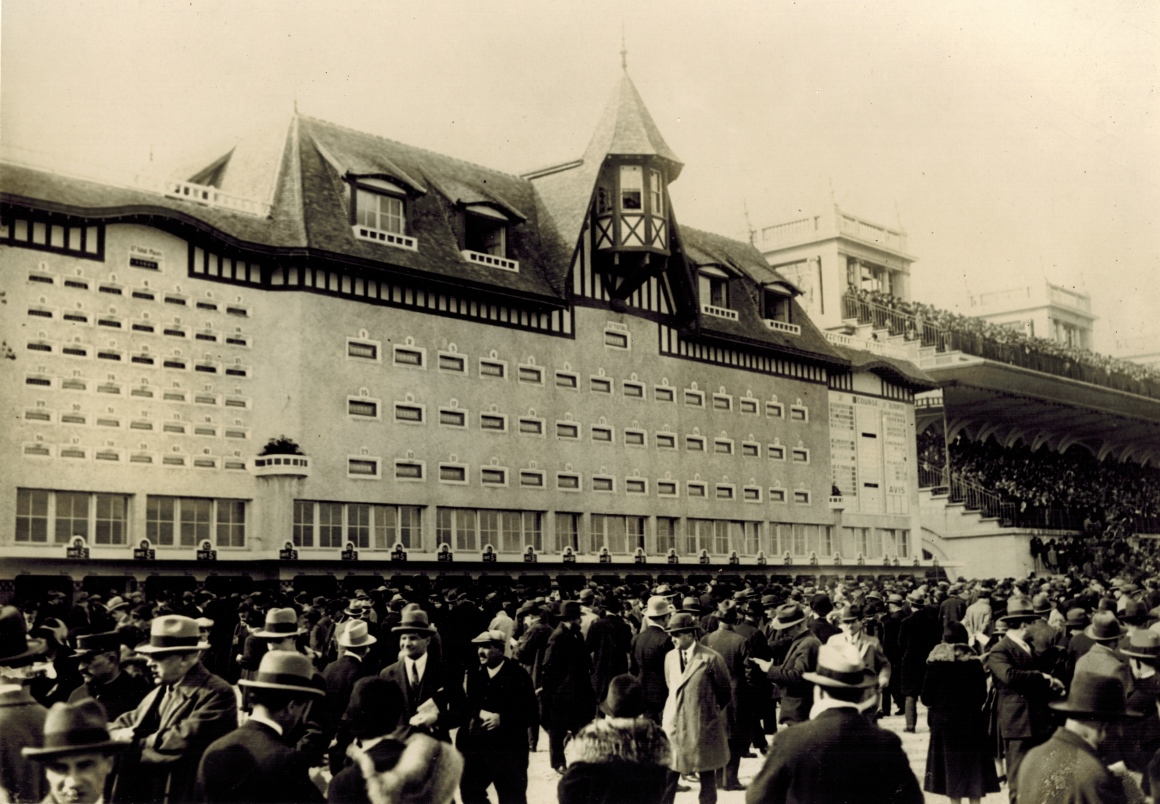Following is an extract from the company document mentioned above that appears close to this image in that document. This extract is the third in a sequence of extracts from the company document contained in multiple Photo Gallery pages of this website. This extract follows the one in the Photo Gallery page associated with the image of Gloucester Park Trotting Track. It relates to a comparison of the old punter Runner Total and Pool Grand Total displays with the new Odds Displays which were available with Julius Totes after 1927 when George Julius invented the world's first odds computer and Automatic Totalisators Limited started manufacturing them. The old method of displaying the runner totals for each pool and the pool grand totals can be seen in this image. On the protruding central section of the near stand there are 42 small rectangular windows arranged in 3 rows and 14 columns. These windows contain the Julius Tote runner total investments for each runner in a race catering for a maximum field size of 42. As this is the predominant display I am almost certain this is for the Win Pool. The single similar window, central above the top row of runner totals is the pool grand total investment of all the runners below. There is a smaller indicator in the left hand recessed part of the stand consisting of smaller windows arranged in 6 rows and 7 columns catering for the same maximum field size of 42. Similarly the window above the top row of runner total windows, displays the grand total of investment on all the runners below. If the larger indicator is for the Win pool then this indicator is for the Place pool. Do you get the impression the Win pool is significantly more important than the Place pool? I do! I worked on totalisator systems in the digital computer based totalisator era starting half a century after this Julius Tote commenced operation and there was generally much more investment in the Win pool than the Place pool. The company document extract follows:
In almost every totalisator installation, the Government or the Race Club makes a percentage deduction on the total moneys invested on every race. If, as has been the practice in the past, the totalisator records merely the aggregate number of tickets sold on the race, and the number of tickets sold on each horse, the bettor, in order to determine what his dividend is likely to be, has first to deduct the Government or Club tax from the grand total investment. Next, if it is a "Place" machine, he has to divide up the remaining amount on a certain fixed percentage basis to determine the amount of the pool available for the backers of each of the placed horses. Finally, he must divide the number of numbers so obtained by the number of tickets sold on the particular horse in which he is interested. Whilst he is dong all this, the wheels of the machine are rapidly moving and only those bettors who are continually using the machine, and who thus may have become quick at approximating the result, can obtain anything other than a very approximate idea of the amount of the dividend that they have a chance of winning.
Realising this disability, and realising also that the use of the mechanical totalisator is now spreading into countries which for years past, have handled all betting transactions through bookmakers (who, when making the sale, definitely inform the investor of the dividend to be paid if the horse is successful) the inventor of the Premier machine has concentrated upon the production of equipment that will do the whole of these calculations automatically and instantaneously, so that the machine, instead of merely displaying the number of tickets sold, may give the investor the information that he is seeking, namely the amount of dividend that he would actually receive (at the moment he makes his bet) should his horse prove to be the winner. These efforts have been entirely successful and such equipment is now available, and can be installed on any racecourse.
It may be added that, although the mechanical operation involved in making such calculations appears to be very complicated, yet the continuous addition, the percentage deduction, the division of pool between placed horses, and the final division of this last result by the number of investments on each horse, are in fact effected with very simple and positive mechanism. The Premier Machine available to-day, and which combines all these advantages, is very much simpler than the mechanism originally installed in Auckland in 1913, which latter only gave the total of the tickets sold on each horse, and left the whole of the remaining calculations to be done by the investor.
The text immediately following this extract can be read by clicking on the image above and scrolling down in the index table to and selecting the image icon for the Ceylon Turf Club Colombo.
